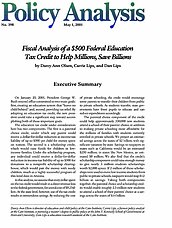On January 20, 2001, President George W. Bush entered office committed to two main goals: first, creating an education system that “leaves no child behind” and, second, providing tax relief. By adopting an education tax credit, the new president could take a significant step toward accomplishing both of those important goals.
The education tax credit under consideration here has two components. The first is a parental choice credit, under which any parent could receive a dollar-for-dollar reduction in income-tax liability of up to $500 per child for money spent on tuition. The second is a scholarship credit, which would raise funds for children in low-income families. Under the scholarship program, any individual could receive a dollar-for-dollar reduction in income-tax liability of up to $500 for donations to a nonprofit scholarship clearinghouse, which would pair the money with needy children, much as a highly successful program of this kind does in Arizona.
In this analysis, we assume that every dollar spent on the tax credit would result in a direct revenue loss to the federal government, for a total cost of $9.2 billion. At the state level, however, use of the tax credit results in tremendous savings. By reducing the cost of private schooling, the credit would encourage some parents to transfer their children from public to private schools. As students transfer, state governments have fewer pupils to educate and can reduce expenditures accordingly.
The parental choice component of the credit could help approximately 330,000 new students attend a school of their parents’ choice, in addition to making private schooling more affordable for the millions of families with students currently enrolled in private schools. We project an estimated savings across the states of $2 billion, with significant variation by state. Savings to taxpayers in states such as California would be an estimated $250 million; in states like New Mexico, an estimated $8 million. We also find that the credit’s scholarship component could raise enough money to give nearly 3 million students scholarships worth $2,000 apiece. If 2 million of those scholarships were used to move low income students from public to private schools, taxpayers would reap $12 billion in savings. Taking both components together, the parental choice and scholarship credits would enable roughly 2.3 million new students to attend a school of their parents’ choice at a savings across the states of $14 billion.
About the Authors

This work is licensed under a Creative Commons Attribution-NonCommercial-ShareAlike 4.0 International License.
